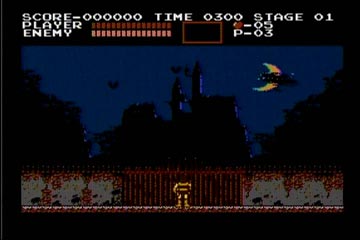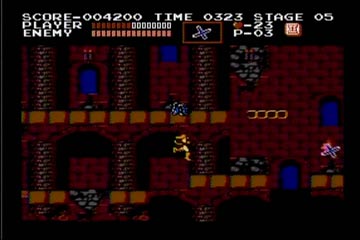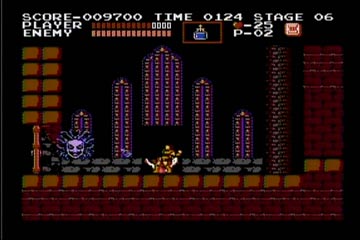
Ah, Hallowe’en. A time to get individually sized candies the days after for dirt cheap prices. A day to waste a perfectly good pumpkin for target practice for the local juvenile delinquents instead of an awesome pie. Yes a time to scare ourselves with horror marathons on television that will eventually be Ghostbusters over and over again. A time to dress up in alluring outfits for your significant other or your close friends. Not me, however. I don’t have a girlfriend to wear the sexy nurse outfit, and hell, it doesn’t fit me anymore.
So, what better tradition to keep from my childhood onward than the annual playing of Castlevania, for the NES.
The game that has started a series that has lasted just as long as Mario, Link, Sonic, and the other major contributors to the gaming worlds. Even if you played the near-perfect Super Castlevania 4 for Super Nintendo, the different Simon’s Quest also for the NES, or the widely praised Symphony of the Night for the Playstation, the battle for Dracula has gone on as long as there has been a controller, and will keep going long after we have been mummified and become his slave.
The game starts up, and in the five second cut scene, with no words, just ominous music, and you know exactly what the story is. Some dude with a whip is coming after Dracula, to finish him off once and for all. Little does he know that it’s just getting started. That opening cut scene, by the way, is so awesome, and there’s so little to it, that that’s what makes it memorable. It’s literally just our hero, Simon Belmont, walking up to the gates of the castle.

This is your standard side scrolling game, walking, jumping and killing bad guys. Your main weapon is a whip that can be upgraded to a more powerful chain whip. You also get a side weapon, that cost-per-use using hearts you collect, that can increase your range and damage output, including daggers, axes and holy water. These weapons became staples to all Castlevania games, and are an excellent way to give an advantage to the player. Each one has it’s benefits and hindrances, and it’s up to the players style of gaming to know which game is the best.
There are six stages altogether, including six end bosses that include Medusa, mummies, Frankenstein and the Grim Reaper. And of course, fighting Dracula in the end. If that isn’t a cornucopia of awesomeness, I don’t know what is. The appeal to have all sorts of staples of horror, rolled into one game makes it perfect for this type of year.

With great controls, beautiful graphics, and an incredible soundtrack, there is a reason why this game is a must have to all collectors of the cartridges.
However, there are some dark areas of the game that need to be addressed.
The first, is very noticeable on the first encounter with damage. The knockback. This irritant has become more common among other side scrollers, including more Castlevania games, and games like Ninja Gaiden. When you get hit by anything, you fly back a certain distance, and it’s uncontrollable and irritating. This become abundantly clear how bad it is when you are doing any platform jumping and anything hitting you, there’s a good chance your projected off a cliff or into the water to drown a most painful death. This will be a large percentage of your death in this game.

The other percentage of your deaths will be from the bad guys themselves. They are merciless. Some are as simple as walking in a linear ground path, but others are so erratic that it becomes frustrating. There are the medusa heads that move in a wave format, the Axe-men that back up to prevent you from hitting them, and most importantly, those damn whatever-the-hell-they’re-called. According to the instructions, they’re Hunchbacks, but to me, they will always be called whatever-the-hell-they’re-called. They are frustratingly annoying to hit, and dodging them is next to impossible. In one part of the game, you are bombarded with them, and you have to result into running away or praying that your whip finds the back end of their asses.
One other thing to mention is the health bar. The first few levels, the bar is not much of a factor, as the bosses and enemies are relatively easy. Afterwards, however, that “bar” is moot. Every creature at one point in the game takes a quarter of your life with every hit. That means your hit points is essentially four. It’s so aggravating. There is one room going to face the Grim Reaper where you have to dodge medusa heads while fighting axe-men. If you unsuccessfully dodge a head, or an axe, that’s one out of four pips of life you don’t get when facing and fearing the Reaper. And if you lose, you lose the side weapon and ammunition hearts you collected, and have to resort to starting the stage over again, or using the lowly weapon it defaults you to in the candles.
Fighting Dracula is no picnic either. You have to hit him a total of 32 times, while you can only take 4 hits. Perfection is mandatory. But before you do, climb the iconic stairs up to him, collect the holy cross boomerang, and as many hearts as possible. Climb down the stairs and repeat, and try to get your 2x or 3x bonus to throw more boomerangs. You’ll have a chance in hell of beating him.
The challenge of the game is to overcome these annoying factors and sometimes. It feels like leeches crawling inside your skin. There are points in the game where you feel like it’s been hours since you progressed, and since there are unlimited continues, it’s like Dracula is actually sending you to hell to torture your soul. But the satisfaction of actually conquering your demons and facing these challenges are worth it.
As maddening as the game will make you, this game is great, and stands out as another mandatory game in any NES collection. Even as most newer Castlevania games become similar to Symphony of the Night, it’s great to try the game where it all began, and I recommend it thoroughly. Even if you think the later games are better, giving this game a once over is still highly recommended. I suggest you whip it. Whip it good.